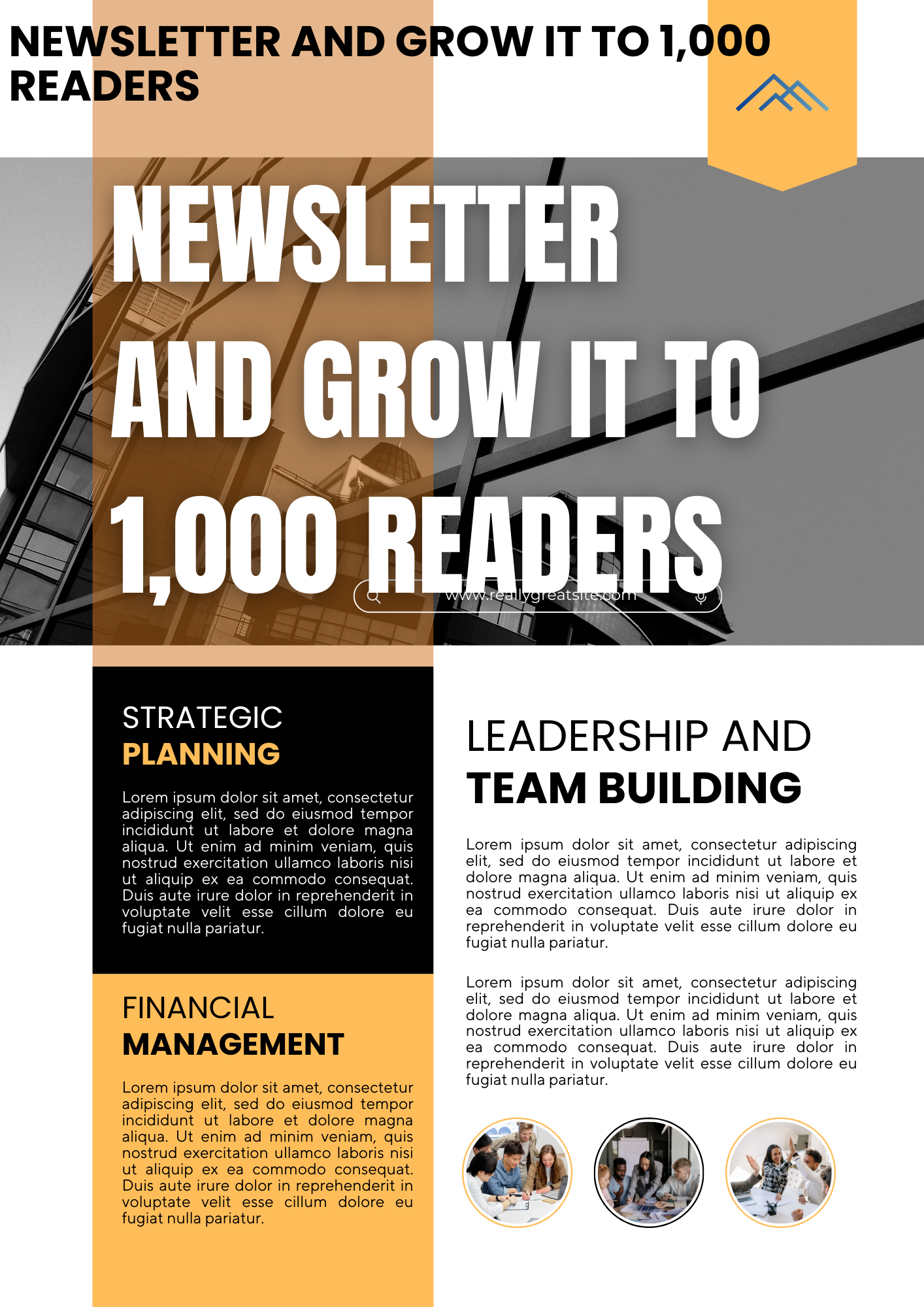Start a Newsletter and Grow It to 1,000 Readers Free
Introduction: Why Students Should Start a Newsletter
Have you ever dreamed of having your own audience who actually cares about what you write? Imagine this: you share your study tips, personal experiences, or even productivity hacks, and over 1,000 people look forward to reading your words every single week. That’s the strength of building your own newsletter.
A newsletter is not just an email you send out—it’s your personal space on the internet where you build a community, share knowledge, and create opportunities for yourself. Unlike social media platforms—where algorithms decide who sees your content—a newsletter lands straight in your reader’s inbox, giving you direct access without any gatekeepers. When someone subscribes, it’s their way of saying: ‘I’m interested in what you have to share.’”
And here’s the exciting part: newsletters are no longer reserved for professional marketers, big businesses, or tech influencers. Today, even students are starting newsletters to build their personal brands, showcase skills, and sometimes even make money online. The best part? Starting a newsletter is free—no money needed. With free tools available, you can launch your own newsletter in just a few hours.
But before diving into the technical setup, let’s explore why students should seriously consider starting a newsletter in 2025.

1. Skill Development That Goes Beyond the Classroom
“Newsletters help you get better at communication and storytelling.” You’ll learn how to write clearly, structure your thoughts, and connect with readers. In a world where digital skills matter more than ever, this is a huge advantage.
Beyond writing, you’ll also pick up practical digital marketing skills. You’ll learn about:
Email design – making your newsletter look professional.
Branding – creating a consistent voice and style.
Analytics – understanding what readers like and what makes them click.
These are skills employers love. Even if you don’t plan on making money from your newsletter, you can showcase it on your resume or LinkedIn profile as proof of your initiative and digital expertise.
2. Build Authority in Any Field
Think about the subjects or topics you love—fitness, coding, finance, productivity, mental health, or even gaming. Writing regularly makes you a mini-expert in your niche.
For example:
A computer science student can share coding tips and project tutorials.
A fitness enthusiast can write weekly workout and diet hacks.
A literature student can share book recommendations and study notes.
When people start trusting your content, they see you as a credible voice. Over time, this authority can help you get freelance work, internship offers, or speaking opportunities—all because you started sending emails.
3. Networking and Opportunities
One of the biggest hidden benefits of a newsletter is the connections you makeSubscribers aren’t just numbers—they’re relationships.
Readers often reply to emails, ask questions, or share feedback. Some may become collaborators, clients, or even mentors. Imagine writing about your passion for productivity and getting noticed by a startup that invites you for a remote internship. That’s the kind of opportunity a newsletter can create.
Unlike social media, where interactions get buried in comments, newsletters open the door to real, personal conversations.

4. Monetization Potential
Let’s be real—students always want extra income. While you shouldn’t start a newsletter just for the money, it definitely has long-term earning potential. Once you build a loyal subscriber base, here are some ways you can monetize:
Affiliate Marketing – Share tools or books you genuinely use and earn a commission.
Sponsorships – Brands pay to feature their product in your newsletter once you have enough subscribers.
Digital Products – Sell eBooks, templates, or guides directly to your readers.
Paid Subscriptions – Offer premium content for a small monthly fee.
Even with just 500–1,000 subscribers, you can start generating income. And since the tools to launch are free, your profit margin is 100%.
5. Breaking the Myth: You Don’t Need Paid Software
Many beginners believe they need expensive tools like Mailchimp, ConvertKit, or Substack Pro to start. That’s simply not true.
Today, you can find powerful free tools that make it easy to:
Collect email subscribers.
Send unlimited newsletters.
Track open rates and performance.
Even design beautiful layouts.
Students can use platforms like Substack, MailerLite (free plan), or even ConvertKit’s free tier to get started. This means you can start your journey without spending a single rupee or dollar.
6. What You’ll Learn in This Guide
Now that you understand the “why,” let’s look at the “how.” This guide is designed for students who want to start small but dream big. Here’s what we’ll cover step by step:
Step-by-step process: from creating your account to sending your first email.
Best free tools to use – detailed reviews so you can choose the right platform.
How to grow your list from 0 to 1,000 readers – strategies that actually work for students.
Monetization tips – simple ways to turn your newsletter into a side income stream.
Common mistakes to avoid – so you don’t waste time on the wrong things.
Real student examples – because nothing motivates you more than seeing peers succeed.
7. Why Start Now?
You might be thinking: “Should I wait until I graduate or have more experience?” The answer is no. Starting as a student gives you a unique edge:
You have fresh ideas and perspectives that people want to hear.
You can grow slowly and consistently without pressure.
By the time you graduate, you could already have an audience of thousands.
The earlier you start, the sooner you learn, build authority, and enjoy the benefits.
Final Words Before We Begin
Starting a newsletter may seem like a small step, but it can create a huge impact on your personal, academic, and professional life. Whether you want to improve your writing, build a personal brand, or even earn extra income, a newsletter is one of the easiest and most rewarding projects you can begin—without any investment.
👉 So grab a notebook (or open Google Docs), because in the next sections, we’re going to design your newsletter journey from zero to 1,000 readers—using free tools only.
Your audience is out there waiting. Just one click—hit ‘send’ and you’re done
Step 1: Choose Your Newsletter Topic 🎯
Before launching your newsletter, the first thing you need to decide is what you’ll write about. Many beginners get stuck here because they either pick a topic that’s too broad or something they can’t consistently write about.
✅ A simple formula to choose your topic:
Pick something you genuinely enjoy learning or talking about.
Check if people are searching for it online.
Make sure you can easily write at least 20 different ideas around that subject.
Example Topics for Students
Productivity tips for students
Health and fitness hacks
Coding tutorials or tech guides
Personal finance and money-saving tips
AI tools and digital resources for students
📌 Pro Tip: Use free tools like Google Trends or Ubersuggest to quickly check if your topic has enough demand. If people are already looking for it, chances are your newsletter will gain readers faster.
Step 2: Select a Free Newsletter Platform 🛠️
Once your topic is ready, choose a free platform to deliver your newsletter.Here are the best student-friendly platforms:
1. Substack
Best for Beginners
If you’re new, Substack offers a hassle-free way to get started.. It combines a blog and email in one place, so you don’t need any technical knowledge.
Features:
100% free to start.
Publish posts online and email them to subscribers.
Readers can comment on your posts.
Built-in monetization (paid subscriptions).
How to Get Started:
Go to Substack.
Sign up with your email.
Choose a name for your newsletter.
Write your first post and hit publish.
Pros:
✅ Super easy to use
✅ Free forever
✅ Looks professional
✅ Monetization available
Cons:
❌ Limited design customization
❌ Substack branding always visible
👉 My Take: Perfect for students who want a no-stress, plug-and-play newsletter without technical work.

2. Beehiiv
Best for Growth & Analytics
Beehiiv is newer but very powerful. Many creators like it because it has strong tools for growing your audience.
Features:
Free plan for up to 2,500 subscribers.
Growth features like referrals and recommendations.
Clean, modern design.
How to Get Started:
Sign up at Beehiiv.
Customize your newsletter design.
Import any existing subscribers.
Publish your first newsletter.
Pros:
✅ Excellent analytics
✅ Strong growth tools
✅ Generous free plan
Cons:
❌ Fewer design options compared to Mailchimp
❌ Still improving as it’s a new platform
👉 My Take: If you’re serious about reaching 1,000 readers fast, Beehiiv gives you better tools to track and grow.
3. Mailchimp (Free Plan)
Best for Professional Design
Mailchimp stands out as one of the most trusted and long-running email marketing platforms It’s slightly more advanced than Substack, but great if you want polished, branded emails.
Features:
Drag-and-drop email builder.
Free plan for up to 500 subscribers.
Dozens of professional templates.
Basic automation included.
Pros:
✅ Polished, professional designs
✅ Many integrations (useful as you grow)
✅ Trusted by businesses
Cons:
❌ Free plan capped at 500 subscribers
❌ Can feel overwhelming for beginners
👉 My Take: Choose Mailchimp if you want your emails to look like a company-style newsletter.
📊 Comparison Table: Best Free Newsletter Tools
| Tool | Best For | Free Limit | Pros | Cons |
|---|---|---|---|---|
| Substack | Beginners | Unlimited readers | Easy, free forever, simple | Limited customization |
| Beehiiv | Growth & Analytics | 2,500 subscribers | Growth tools, strong analytics | Fewer design templates |
| Mailchimp | Professional Design | 500 subscribers | Beautiful templates, branding | Learning curve |
How to Grow Your Newsletter to 1,000 Readers (and Make Money as a Student) 🚀
So you’ve picked your topic and chosen a free platform like Substack, Beehiiv, or Mailchimp. Great start! But here’s the truth: simply creating a newsletter won’t magically bring in readers. The real challenge is growth—getting from 0 to 1,000 subscribers.
The good news? With the right strategies, students can grow an email list quickly—even without spending a single rupee or dollar. Let’s break it down step by step.
Step 3: Grow Your Newsletter to 1,000 Readers 🚀
Think of your newsletter like a party. You can set up the venue, decorate, and prepare snacks, but unless you invite people, no one will show up. That’s why promotion is key.
Here are some student-friendly growth strategies:
1. Social Media Cross-Promotion 📱
Leverage the platforms where you’re already active—whether it’s Instagram, LinkedIn, X (Twitter), or TikTok—to share your newsletter and attract new subscribersPost highlights or small tips from your newsletter as reels, tweets, or stories. Always add:
👉 “Want more? Subscribe to my free newsletter.”
✅ Works well because short content builds curiosity.
2. Lead Magnet Strategy 🎁
People love free stuff. Create a simple digital freebie—like a PDF guide, checklist, or cheat sheet—and give it in exchange for an email sign-up.
Example: “Free 10 Study Hacks PDF—Join my newsletter to get it.”
✅ Students can easily make a free guide using Canva.

3. WhatsApp & Telegram Groups 💬
If you’re part of study groups or clubs, share your newsletter link there. SBecause they’re warm audiences (friends, classmates, peers), reaching your first 50–100 subscribers is easier.
4. Blog + Newsletter Combo ✍️
Start a free blog on WordPress or Blogger, write short posts, and add your newsletter sign-up link at the end.
👉 Related Post: How to Start a Blog and Earn from AdSense (Beginner Guide)
✅ Blogs attract readers via Google, giving your newsletter long-term growth.
5. Collaborations & Shoutouts 🤝
Find other students who run newsletters or blogs. Exchange shoutouts like: “Hey, check out my friend’s study tips newsletter.”
✅ This way, you borrow each other’s audience.
📌 Real-Life Example:
One example is a student from India who launched a Productivity Newsletter on Substack. By sharing weekly “study hacks” on Instagram Reels, she grew from 0 to 1,200 subscribers in just 3 months—without spending a single rupee.
Step 4: Monetize Your Newsletter 💰
Once you reach 1,000 readers, you’ve built something very valuable. Now, you can start making money. Here are the most popular monetization methods for students:
1. Affiliate Marketing 🔗
Recommend tools, apps, or books that you personally use.Every time someone makes a purchase through your unique link, you earn a commission—this is the core of affiliate marketing.
Example: Share links to study planners, software like Grammarly, or budget apps.
2. Sponsored Posts 🤝
Brands pay to be featured in your newsletter if your audience is active and relevant. For example, an ed-tech startup might sponsor your “Top 5 Study Apps” issue.
3. Digital Products 📘
Create and sell your own eBooks, Notion templates, or online courses. Students love ready-to-use resources.
Example: “30-Day Study Planner – Notion Template” for $5.
4. Paid Newsletter 🔒
Offer free weekly content, but keep premium guides behind a paywall. Platforms like Substack make this super easy.
Common Mistakes Beginners Make ❌
Avoid these traps if you want to grow faster:
Copying others’ designs without adding your own touch.
Writing long, boring essays instead of short, useful tips.
Ignoring keywords (you’ll miss SEO traffic).
Not promoting enough (just waiting for readers).
Quitting too soon (growth usually takes 3–6 months).
Bonus Tips 🌟
Stick to 1–2 emails per week. Consistency matters more than frequency.
Use short, catchy subject lines. Example: “3 Hacks to Study Faster ⏳”
Tell stories—don’t just list tips. Stories keep readers hooked.
Always add a call-to-action (CTA) like: “Reply with your favorite hack” or “Share this with a friend.”
FAQs (for Students) ❓
Q1. Which free newsletter platform is best suited for students?
👉 Substack is the easiest for beginners. Beehiiv is better if you want fast growth.
Q2. How much time does it usually take to grow a newsletter to 1,000 subscribers?
👉 With consistency, you can do it in 3–6 months.
Q3. Can I make money from a free newsletter?
👉 Yes! You can monetize your newsletter through affiliate marketing, brand sponsorships, and by selling your own digital products.
Q4. Do I need a blog to start a newsletter?
👉 No, but having a blog helps you get more readers from Google.
Q5. How can I get my first 100 subscribers?
👉 Start with friends, classmates, and social media groups. Offer a free resource to make sign-ups attractive.
Conclusion 🎯
Starting a newsletter is one of the smartest career moves for students in 2025. With free tools like Substack, Beehiiv, and Mailchimp, you don’t need money—just consistency and creativity.
Once you hit 1,000 readers, you open doors to:
Personal branding
Networking opportunities
Side income streams
Now it’s your turn:
👉 Which newsletter software will you try out first? Share in the comments!
Internal Links
How to Start a Blog and Earn from Google AdSense (Beginner Guide)
How to Build a Personal Brand on Social Media (Step-by-Step)
🌍 External Links (high-authority references)
Mailchimp Free Plan – Free email marketing tool.
Substack – A popular platform for creators to start newsletters.
HubSpot Blog – Great marketing resources.
ConvertKit Free Plan – Another good option for beginners.
Start a Newsletter and Grow It to 1,000 Readers Free Start a Newsletter and Grow It to 1,000 Readers Free Start a Newsletter and Grow It to 1,000 Readers Free Start a Newsletter and Grow It to 1,000 Readers Free
Start a Newsletter and Grow It to 1,000 Readers Free Start a Newsletter and Grow It to 1,000 Readers Free Start a Newsletter and Grow It to 1,000 Readers Free